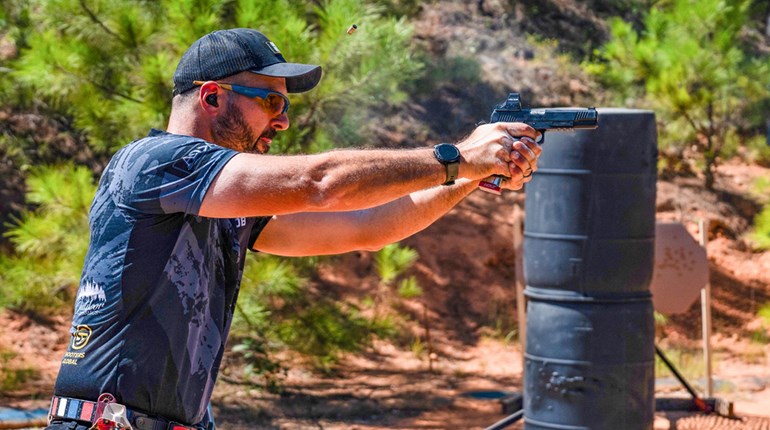
Keeping the dot as small as possible will aid accuracy, while a larger dot fosters faster shooting.
I spend at least one day every week shooting several hundred rounds through other people’s rifles as accurately as I can. That means I use all manner of sighting systems, selected by and for other shooters. While I may have preferences for one type over another, I have developed some tricks to maximize accuracy with most of the sights I encounter. Whether using “irons,” red-dot/reflex types or magnified optics, each sighting system presents unique challenges for precise aiming. Learning to maximize the pictures they present will help you to shoot more accurately.
Iron Sights
I realize they are more likely to be aluminum or polymer these days, but I still call open sights “irons” for simplicity’s sake. Your choice may be back-up sights for an optic, or they may be all you have to align your bore with whatever you plan to shoot. Either way, the main problem we are faced with when attempting to be accurate with open sights is they are not usually made for precision shooting. Instead, those sights are there mainly for two reasons: First, so a manufacturer can sell a rifle that is ready to shoot, and second, to provide you with a rudimentary means to aim at stuff. The human eye is pretty good at centering things in the middle of a rear sight, be it a peep, a notched blade, buckhorn or one of the stylish new geometric apertures. The bigger problem is most front sight posts cover the bulk of any target smaller than a hybrid car at 100 yards. We shoot our best when we focus the dominant eye on the front sight—not the target. So the post should be well-defined against the backdrop of the target. Fortunately, aftermarket front posts are available for screw-in type tactical sights. Some are thin and others are sharply pointed or brightly colored. Stay away from the bright ones if you like to shoot tight groups in daylight. Even though my eyes remind me of my age daily, I can shoot very well with a fine front post on a rifle. Guns with fixed front sights, such as older-style lever- and single-shot rifles, often allow replacement sights to be drifted into barrel dovetails. A steady hand and a small needle-file set will thin your existing front post or a gunsmith can do the job professionally. A few hundred years ago when I was in Army basic training, our drill instructors used flat-black sight paint to reduce glare on our front posts and that made a huge difference in the South Georgia sunlight. I still blacken my front posts to this day.
Powered Optics
Red-dot and reflex/type sights present several unique challenges when you push your shooting game beyond close-quarter shots at silhouette-sized targets. Aiming at smaller objects is a challenge due to the bright “fuzz” or halo effect we see around our illuminated dots, circles and chevrons. One simple trick is to dim down the aiming point as much as lighting conditions allow. You can zero the tip of a shaped reticle—like a triangle or arrow—and shoot very respectable groups using those fine points. Adding a magnifier behind a reflex or holographic sight usually reveals that your “dot” is really a splotch or a kidney-bean-shaped blob. Once you adjust the rheostat down as far as you can stand to, pick a singular point somewhere on the blob—the tip of the bean, for instance—and zero to that point. You will likely find the main body of the dot works great for rapid stuff and larger targets while using the zero point allows you to make tougher shots. If your optic is powered by some type of fiber optic, try placing a small piece of tape over the fiber on bright days so it does not wash out your target.
Riflescopes
Aiming magnified optics with etched or wire reticles is not all that complicated, but a few simple techniques may help your eyes make full use of these tools. Most scopes built in the last 75(ish) years have some form of eyepiece focus. Modern tactical scopes typically have rapid-focus rings at the rear edge of their eyepieces. Traditional scopes usually require the eyepiece itself to be rotated. The goal is to ensure your reticle is as crisp as it can be. If your scope has a parallax adjustment, use it to bring your target in focus with the reticle and remember this setting needs to be tweaked for different distances. Once focused, use your reticle to help take your mind off the shot. Trust me on this: concentrating too hard on the perfect trigger pull while simultaneously worrying about blowing the shot will almost always result in a blown shot.
Use the reticle as a mental distraction by trying to perfectly quarter whatever you are aiming at when shooting for maximum accuracy. I concentrate so fully on the perfect centering of my reticle that my mind is too occupied to worry about making a good shot and I nearly always shoot better as a result. Naturally this is not a rapid-fire technique, but you will find that over time you will do it quickly and instinctively, regardless of the situation. If you are struggling with poor shots while using a high-power scope, dial down the power a bit to reduce the amount of wobble you see. Oftentimes you will end up achieving better shooting at lower powers.
Remember to give your eyes a break and do not stop breathing for too long as you struggle for precision. Oxygen deprivation affects the eyes very quickly and compels us to rush the shot. If you are taking too long, relax, breath, focus your eyes on something distant and naturally colored, like trees or grass for a moment, then get back on your sights, make the next shot count, follow through and do it again.


































